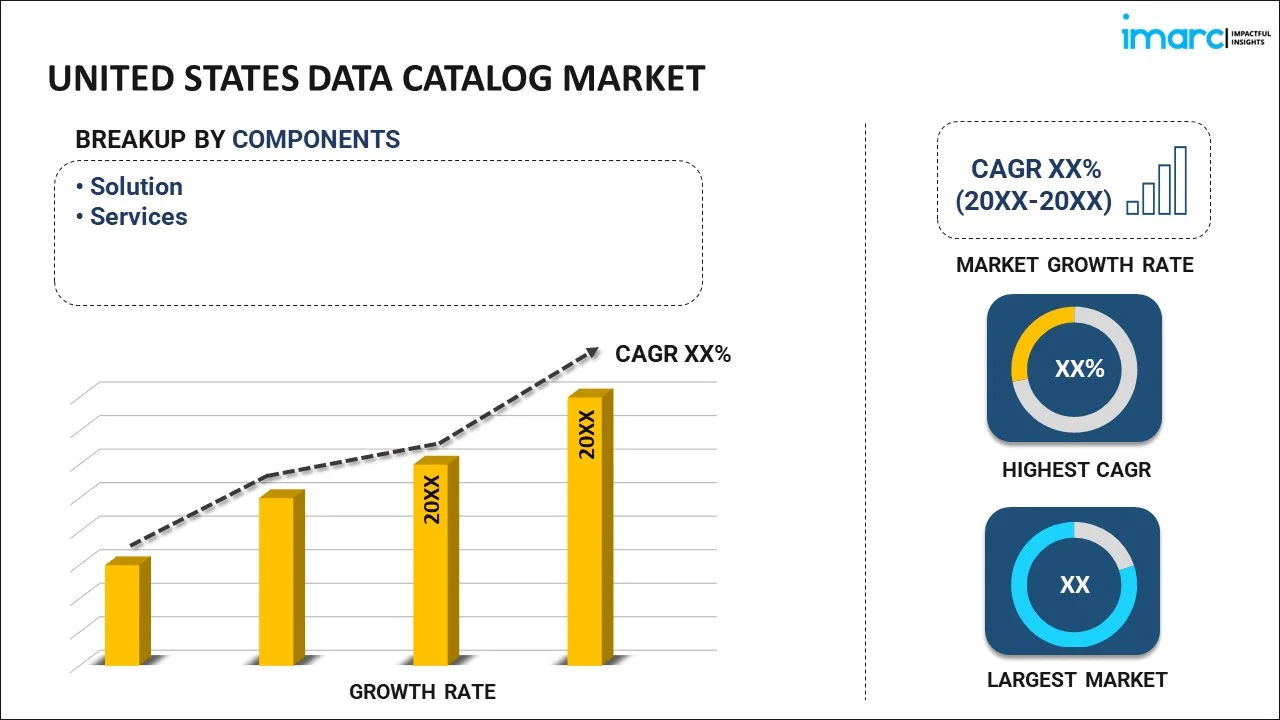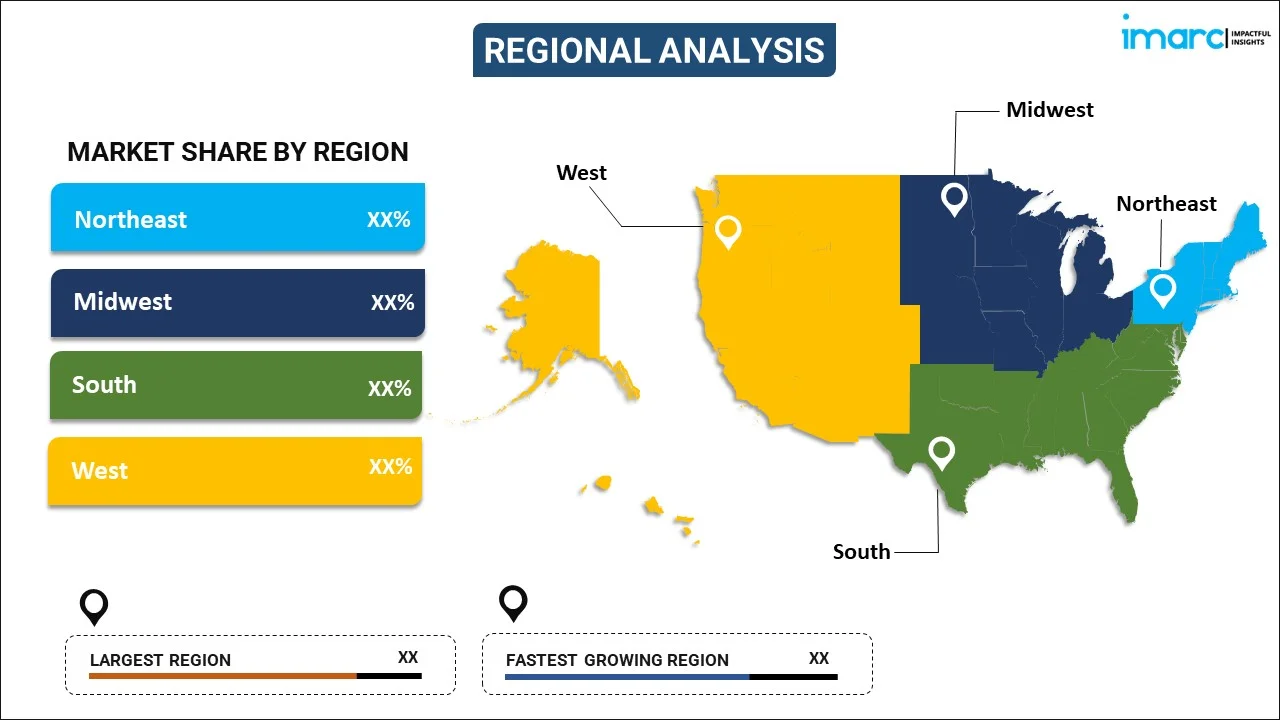
United States Data Catalog Market Report by Component (Solution, Services), Deployment Mode (On-premises, Cloud-based), Organization Size (Small and Medium-sized Enterprises, Large Enterprises), Data Consumer (Business Intelligence Tools, Enterprise Applications, Mobile and Web Applications), End Use Industry (BFSI, Retail and E-Commerce, Manufacturing, Government and Defense, Energy and Utilities, IT and Telecom, Education, Healthcare, and Others), and Region 2025-2033
Market Overview:
United States data catalog market size reached USD 310.3 Million in 2024. Looking forward, IMARC Group expects the market to reach USD 1,790.3 Million by 2033, exhibiting a growth rate (CAGR) of 21.5% during 2025-2033. The increasing growth of business intelligence and analytics initiatives, which has increased the demand for tools that streamline the discovery and utilization of data, is driving the market.
|
Report Attribute
|
Key Statistics
|
|---|---|
|
Base Year
|
2024 |
|
Forecast Years
|
2025-2033
|
|
Historical Years
|
2019-2024
|
| Market Size in 2024 | USD 310.3 Million |
| Market Forecast in 2033 | USD 1,790.3 Million |
| Market Growth Rate (2025-2033) | 21.5% |
A data catalog is a centralized repository that organizes and manages metadata about an organization's data assets. It serves as a comprehensive inventory, indexing, and classification system for various data sources, databases, and datasets within an enterprise. The catalog provides detailed information about the structure, lineage, quality, and usage of data, making it a valuable resource for data discovery, governance, and collaboration. By offering a searchable and user-friendly interface, a data catalog facilitates data exploration and enables users to understand the available data resources, fostering better decision-making and analysis. It helps organizations maintain data transparency, enhance data quality, and ensure compliance with regulatory requirements. Additionally, a data catalog supports data stewardship by empowering data professionals to document, annotate, and update metadata, ensuring that data assets remain accurate and relevant over time. Overall, a data catalog plays a crucial role in promoting data management best practices and maximizing the value of an organization's data assets.
United States Data Catalog Market Trends:
The data catalog market in the United States is experiencing robust growth, primarily driven by the escalating demand for efficient data management solutions. To begin with, the exponential growth of data in diverse formats and from various sources has created a pressing need for organizations to harness this information effectively. Consequently, companies are increasingly recognizing the pivotal role of data catalogs in organizing, classifying, and providing metadata for disparate datasets. Moreover, as businesses continue to adopt cloud-based services, the necessity for streamlined data governance and metadata management has intensified. This is particularly evident in industries such as finance, healthcare, and e-commerce, where compliance requirements and data security concerns are paramount. Consequently, the data catalog market is witnessing a surge in adoption as organizations seek comprehensive solutions to navigate the intricacies of data governance in cloud environments. Furthermore, the rising prominence of data-driven decision-making across industries is propelling the demand for intuitive data catalog platforms. By connecting disparate datasets seamlessly, these solutions empower organizations to derive meaningful insights, enhancing overall business intelligence. In essence, the regional data catalog market is being propelled by a confluence of factors, including the surge in data volumes, the transition to cloud-based infrastructures, and the imperative for data-driven decision-making in contemporary business landscapes.
United States Data Catalog Market Segmentation:
IMARC Group provides an analysis of the key trends in each segment of the market, along with forecasts at the country level for 2025-2033. Our report has categorized the market based on component, deployment mode, organization size, data consumer, and end use industry.
Component Insights:

- Solution
- Services
The report has provided a detailed breakup and analysis of the market based on the component. This includes solution and services.
Deployment Mode Insights:
- On-premises
- Cloud-based
A detailed breakup and analysis of the market based on deployment mode have also been provided in the report. This includes on-premises and cloud-based.
Organization Size Insights:
- Small and Medium-sized Enterprises
- Large Enterprises
The report has provided a detailed breakup and analysis of the market based on the organization size. This includes small and medium-sized enterprises and large enterprises.
Data Consumer Insights:
- Business Intelligence Tools
- Enterprise Applications
- Mobile and Web Applications
A detailed breakup and analysis of the market based on data consumer have also been provided in the report. This includes business intelligence tools, enterprise applications, and mobile and web applications.
End Use Industry Insights:
- BFSI
- Retail and E-Commerce
- Manufacturing
- Government and Defense
- Energy and Utilities
- IT and Telecom
- Education
- Healthcare
- Others
The report has provided a detailed breakup and analysis of the market based on the end use industry. This includes BFSI, retail and e-commerce, manufacturing, government and defense, energy and utilities, IT and telecom, education, healthcare, and others.
Regional Insights:

- Northeast
- Midwest
- South
- West
The report has also provided a comprehensive analysis of all the major regional markets, which include the Northeast, Midwest, South, and West.
Competitive Landscape:
The market research report has also provided a comprehensive analysis of the competitive landscape in the market. Competitive analysis such as market structure, key player positioning, top winning strategies, competitive dashboard, and company evaluation quadrant has been covered in the report. Also, detailed profiles of all major companies have been provided.
United States Data Catalog Market Report Coverage:
| Report Features | Details |
|---|---|
| Base Year of the Analysis | 2024 |
| Historical Period | 2019-2024 |
| Forecast Period | 2025-2033 |
| Units | Million USD |
| Scope of the Report | Exploration of Historical and Forecast Trends, Industry Catalysts and Challenges, Segment-Wise Historical and Predictive Market Assessment:
|
| Components Covered | Solution, Services |
| Deployment Modes Covered | On-premises, Cloud-based |
| Organization Sizes Covered | Small and Medium-sized Enterprises, Large Enterprises |
| Data Consumers Covered | Business Intelligence Tools, Enterprise Applications, Mobile and Web Applications |
| End Use Industries Covered | BFSI, Retail and E-Commerce, Manufacturing, Government and Defense, Energy and Utilities, IT and Telecom, Education, Healthcare, Others |
| Regions Covered | Northeast, Midwest, South, West |
| Customization Scope | 10% Free Customization |
| Post-Sale Analyst Support | 10-12 Weeks |
| Delivery Format | PDF and Excel through Email (We can also provide the editable version of the report in PPT/Word format on special request) |
Key Questions Answered in This Report:
- How has the United States data catalog market performed so far and how will it perform in the coming years?
- What has been the impact of COVID-19 on the United States data catalog market?
- What is the breakup of the United States data catalog market on the basis of component?
- What is the breakup of the United States data catalog market on the basis of deployment mode?
- What is the breakup of the United States data catalog market on the basis of organization size?
- What is the breakup of the United States data catalog market on the basis of data consumer?
- What is the breakup of the United States data catalog market on the basis of end use industry?
- What are the various stages in the value chain of the United States data catalog market?
- What are the key driving factors and challenges in the United States data catalog?
- What is the structure of the United States data catalog market and who are the key players?
- What is the degree of competition in the United States data catalog market?
Key Benefits for Stakeholders:
- IMARC’s industry report offers a comprehensive quantitative analysis of various market segments, historical and current market trends, market forecasts, and dynamics of the United States data catalog market from 2019-2033.
- The research report provides the latest information on the market drivers, challenges, and opportunities in the United States data catalog market.
- Porter's five forces analysis assist stakeholders in assessing the impact of new entrants, competitive rivalry, supplier power, buyer power, and the threat of substitution. It helps stakeholders to analyze the level of competition within the United States data catalog industry and its attractiveness.
- Competitive landscape allows stakeholders to understand their competitive environment and provides an insight into the current positions of key players in the market.
Need more help?
- Speak to our experienced analysts for insights on the current market scenarios.
- Include additional segments and countries to customize the report as per your requirement.
- Gain an unparalleled competitive advantage in your domain by understanding how to utilize the report and positively impacting your operations and revenue.
- For further assistance, please connect with our analysts.
 Inquire Before Buying
Inquire Before Buying
 Speak to an Analyst
Speak to an Analyst
 Request Brochure
Request Brochure
 Request Customization
Request Customization




.webp)




.webp)












